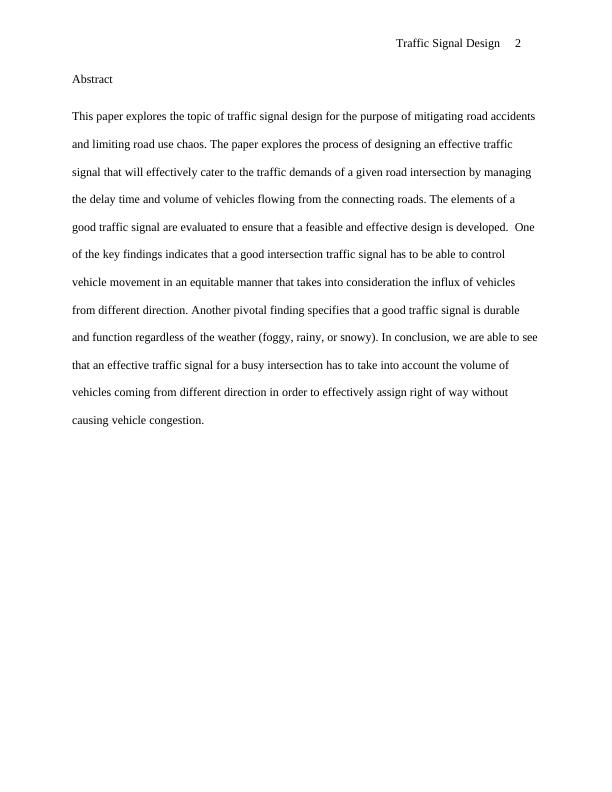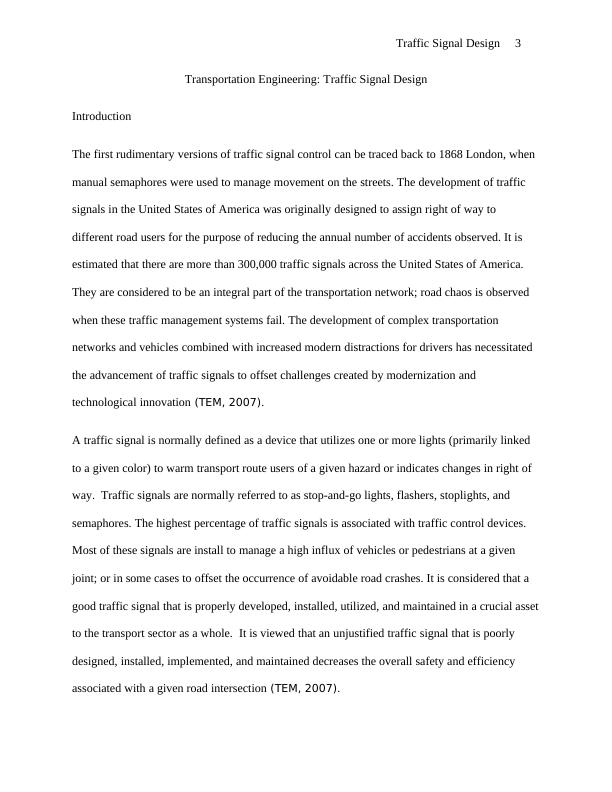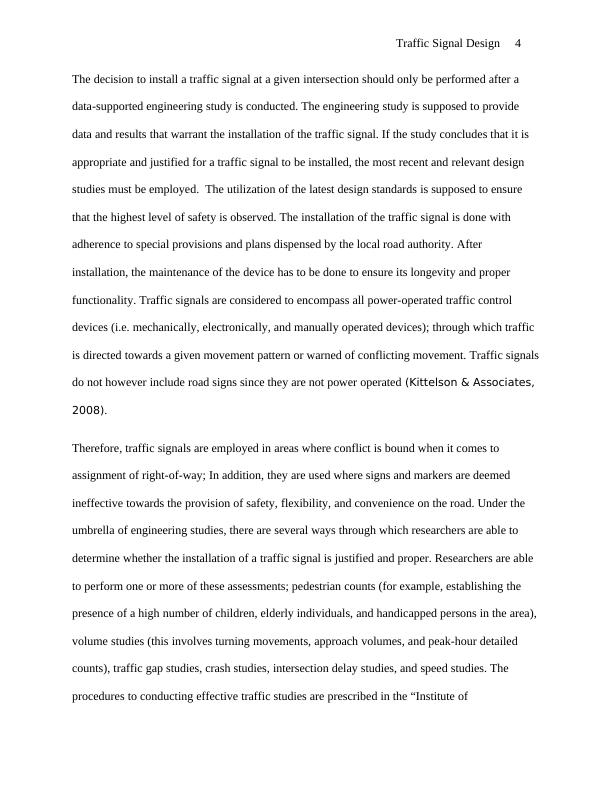Transportation Engineering: Traffic Signal Design
Conduct traffic surveys at four locations and analyze the data for each leg of the intersection.
14 Pages2384 Words311 Views
Added on 2022-10-01
About This Document
This paper explores the topic of traffic signal design for the purpose of mitigating road accidents and limiting road use chaos. The paper explores the process of designing an effective traffic signal that will effectively cater to the traffic demands of a given road intersection by managing the delay time and volume of vehicles flowing from the connecting roads.
Transportation Engineering: Traffic Signal Design
Conduct traffic surveys at four locations and analyze the data for each leg of the intersection.
Added on 2022-10-01
ShareRelated Documents
Traffic Signal Design 1
TRANSPORTATION ENGINEERING: TRAFFIC SIGNAL DESIGN
By (Name)
Professor’s Name
Course Name
University/College Name
City and Location of University (College)
Date
TRANSPORTATION ENGINEERING: TRAFFIC SIGNAL DESIGN
By (Name)
Professor’s Name
Course Name
University/College Name
City and Location of University (College)
Date

Traffic Signal Design 2
Abstract
This paper explores the topic of traffic signal design for the purpose of mitigating road accidents
and limiting road use chaos. The paper explores the process of designing an effective traffic
signal that will effectively cater to the traffic demands of a given road intersection by managing
the delay time and volume of vehicles flowing from the connecting roads. The elements of a
good traffic signal are evaluated to ensure that a feasible and effective design is developed. One
of the key findings indicates that a good intersection traffic signal has to be able to control
vehicle movement in an equitable manner that takes into consideration the influx of vehicles
from different direction. Another pivotal finding specifies that a good traffic signal is durable
and function regardless of the weather (foggy, rainy, or snowy). In conclusion, we are able to see
that an effective traffic signal for a busy intersection has to take into account the volume of
vehicles coming from different direction in order to effectively assign right of way without
causing vehicle congestion.
Abstract
This paper explores the topic of traffic signal design for the purpose of mitigating road accidents
and limiting road use chaos. The paper explores the process of designing an effective traffic
signal that will effectively cater to the traffic demands of a given road intersection by managing
the delay time and volume of vehicles flowing from the connecting roads. The elements of a
good traffic signal are evaluated to ensure that a feasible and effective design is developed. One
of the key findings indicates that a good intersection traffic signal has to be able to control
vehicle movement in an equitable manner that takes into consideration the influx of vehicles
from different direction. Another pivotal finding specifies that a good traffic signal is durable
and function regardless of the weather (foggy, rainy, or snowy). In conclusion, we are able to see
that an effective traffic signal for a busy intersection has to take into account the volume of
vehicles coming from different direction in order to effectively assign right of way without
causing vehicle congestion.

Traffic Signal Design 3
Transportation Engineering: Traffic Signal Design
Introduction
The first rudimentary versions of traffic signal control can be traced back to 1868 London, when
manual semaphores were used to manage movement on the streets. The development of traffic
signals in the United States of America was originally designed to assign right of way to
different road users for the purpose of reducing the annual number of accidents observed. It is
estimated that there are more than 300,000 traffic signals across the United States of America.
They are considered to be an integral part of the transportation network; road chaos is observed
when these traffic management systems fail. The development of complex transportation
networks and vehicles combined with increased modern distractions for drivers has necessitated
the advancement of traffic signals to offset challenges created by modernization and
technological innovation (TEM, 2007).
A traffic signal is normally defined as a device that utilizes one or more lights (primarily linked
to a given color) to warm transport route users of a given hazard or indicates changes in right of
way. Traffic signals are normally referred to as stop-and-go lights, flashers, stoplights, and
semaphores. The highest percentage of traffic signals is associated with traffic control devices.
Most of these signals are install to manage a high influx of vehicles or pedestrians at a given
joint; or in some cases to offset the occurrence of avoidable road crashes. It is considered that a
good traffic signal that is properly developed, installed, utilized, and maintained in a crucial asset
to the transport sector as a whole. It is viewed that an unjustified traffic signal that is poorly
designed, installed, implemented, and maintained decreases the overall safety and efficiency
associated with a given road intersection (TEM, 2007).
Transportation Engineering: Traffic Signal Design
Introduction
The first rudimentary versions of traffic signal control can be traced back to 1868 London, when
manual semaphores were used to manage movement on the streets. The development of traffic
signals in the United States of America was originally designed to assign right of way to
different road users for the purpose of reducing the annual number of accidents observed. It is
estimated that there are more than 300,000 traffic signals across the United States of America.
They are considered to be an integral part of the transportation network; road chaos is observed
when these traffic management systems fail. The development of complex transportation
networks and vehicles combined with increased modern distractions for drivers has necessitated
the advancement of traffic signals to offset challenges created by modernization and
technological innovation (TEM, 2007).
A traffic signal is normally defined as a device that utilizes one or more lights (primarily linked
to a given color) to warm transport route users of a given hazard or indicates changes in right of
way. Traffic signals are normally referred to as stop-and-go lights, flashers, stoplights, and
semaphores. The highest percentage of traffic signals is associated with traffic control devices.
Most of these signals are install to manage a high influx of vehicles or pedestrians at a given
joint; or in some cases to offset the occurrence of avoidable road crashes. It is considered that a
good traffic signal that is properly developed, installed, utilized, and maintained in a crucial asset
to the transport sector as a whole. It is viewed that an unjustified traffic signal that is poorly
designed, installed, implemented, and maintained decreases the overall safety and efficiency
associated with a given road intersection (TEM, 2007).

Traffic Signal Design 4
The decision to install a traffic signal at a given intersection should only be performed after a
data-supported engineering study is conducted. The engineering study is supposed to provide
data and results that warrant the installation of the traffic signal. If the study concludes that it is
appropriate and justified for a traffic signal to be installed, the most recent and relevant design
studies must be employed. The utilization of the latest design standards is supposed to ensure
that the highest level of safety is observed. The installation of the traffic signal is done with
adherence to special provisions and plans dispensed by the local road authority. After
installation, the maintenance of the device has to be done to ensure its longevity and proper
functionality. Traffic signals are considered to encompass all power-operated traffic control
devices (i.e. mechanically, electronically, and manually operated devices); through which traffic
is directed towards a given movement pattern or warned of conflicting movement. Traffic signals
do not however include road signs since they are not power operated (Kittelson & Associates,
2008).
Therefore, traffic signals are employed in areas where conflict is bound when it comes to
assignment of right-of-way; In addition, they are used where signs and markers are deemed
ineffective towards the provision of safety, flexibility, and convenience on the road. Under the
umbrella of engineering studies, there are several ways through which researchers are able to
determine whether the installation of a traffic signal is justified and proper. Researchers are able
to perform one or more of these assessments; pedestrian counts (for example, establishing the
presence of a high number of children, elderly individuals, and handicapped persons in the area),
volume studies (this involves turning movements, approach volumes, and peak-hour detailed
counts), traffic gap studies, crash studies, intersection delay studies, and speed studies. The
procedures to conducting effective traffic studies are prescribed in the “Institute of
The decision to install a traffic signal at a given intersection should only be performed after a
data-supported engineering study is conducted. The engineering study is supposed to provide
data and results that warrant the installation of the traffic signal. If the study concludes that it is
appropriate and justified for a traffic signal to be installed, the most recent and relevant design
studies must be employed. The utilization of the latest design standards is supposed to ensure
that the highest level of safety is observed. The installation of the traffic signal is done with
adherence to special provisions and plans dispensed by the local road authority. After
installation, the maintenance of the device has to be done to ensure its longevity and proper
functionality. Traffic signals are considered to encompass all power-operated traffic control
devices (i.e. mechanically, electronically, and manually operated devices); through which traffic
is directed towards a given movement pattern or warned of conflicting movement. Traffic signals
do not however include road signs since they are not power operated (Kittelson & Associates,
2008).
Therefore, traffic signals are employed in areas where conflict is bound when it comes to
assignment of right-of-way; In addition, they are used where signs and markers are deemed
ineffective towards the provision of safety, flexibility, and convenience on the road. Under the
umbrella of engineering studies, there are several ways through which researchers are able to
determine whether the installation of a traffic signal is justified and proper. Researchers are able
to perform one or more of these assessments; pedestrian counts (for example, establishing the
presence of a high number of children, elderly individuals, and handicapped persons in the area),
volume studies (this involves turning movements, approach volumes, and peak-hour detailed
counts), traffic gap studies, crash studies, intersection delay studies, and speed studies. The
procedures to conducting effective traffic studies are prescribed in the “Institute of

End of preview
Want to access all the pages? Upload your documents or become a member.
